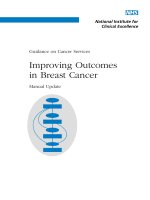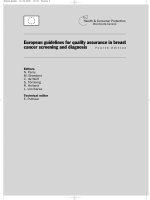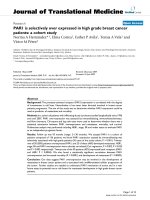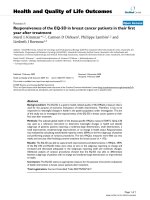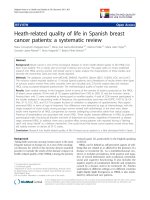SurgicalStrategiesforPreventionandTreatmentofLymphedema in breast cancer patients
Bạn đang xem bản rút gọn của tài liệu. Xem và tải ngay bản đầy đủ của tài liệu tại đây (402.92 KB, 7 trang )
Curr Breast Cancer Rep (2015) 7:1–7
DOI 10.1007/s12609-014-0172-x
LOCAL-REGIONAL EVALUATION AND THERAPY (KK HUNT, SECTION EDITOR)
Surgical Strategies for Prevention and Treatment of Lymphedema
in Breast Cancer Patients
Daniela Ochoa & V. Suzanne Klimberg
Published online: 4 March 2015
# Springer Science+Business Media New York 2015
Abstract The evidence available for risk reduction of lymphedema after breast cancer treatment is sparse and inconsistent.
It is limited by confounding factors such as axillary disease
burden, number of lymph nodes harvested, and radiation
treatment. However, there are several strategies for prevention
and risk reduction prior to the onset of lymphedema. Techniques such as sentinel lymph node biopsy, axillary reverse
mapping, lymphatic anastomosis, and lymphovenular anastomosis are aimed at preventing or minimizing the disruption of
lymphatic flow from the upper extremity. Few surgical procedures, such as the historical Charles procedure, as well as
newer techniques including distal lymphaticovenular anastomosis, lymph node transfer, suction-assisted protein
lipectomy, and low-level laser therapy exist. Nonsurgical
treatments include complete decongestive therapy, pneumatic
compression, Kinesio tape, and exercise. These have varying
degrees of effectiveness but have limitations in patient compliance or availability of certified therapists.
Keywords Axillary dissection . Lymph nodes . Axillary
reverse mapping . Lymphedema . Sentinel . Breast cancer .
Lymphadenectomy
This article is part of the Topical Collection on Local-Regional
Evaluation and Therapy
D. Ochoa
Department of Surgery, University of Arkansas for Medical Sciences,
Slot 725, Little Rock, AR 72212, USA
V. S. Klimberg (*)
Department of Surgery and Pathology, Winthrop P. Rockefeller
Cancer Institute, University of Arkansas for Medical Sciences, Slot
725, Little Rock, AR 72212, USA
e-mail:
Introduction
According to the World Health Organization, as many as 170
million people worldwide and 3–5 million people in the USA
suffer from secondary lymphedema. Current rates of lymphedema in patients being treated for breast cancer depend not
only on what surgery was performed [∼16–25 % following
axillary lymph node dissection (ALND) versus ∼5–8 % following sentinel lymph node biopsy (SLNB)] but also variations with the surgeon, which emphasizes the fact that ALND
and even SLNB are not standardized (Table 1) [1–13]. While
ALND clearly has a two- to three-fold greater rate of lymphedema as SLNB, three times as many patients undergo SLNB
as ALND. Thus, it is important to find strategies to improve
surgical lymphadenectomy and reduce lymphedema, especially when lymphedema results from a negative SLNB. Lymphedema represents one of the most feared complications with
associated psychological distress ranging from 17 to 50 % [14,
15] and is an independent predictor of decreased quality of life
[16], yet lymphedema is one of the most under-recognized,
miscomprehended, relatively unassessed, and underresearched complications of breast cancer (http://www.
cancer.gov/cancertopics/pdq/supportivecare/lymphedema/
Patient/page1).
Because as many and varied procedures have failed to
resolve lymphedema, new strategies for preventing its development are needed. The procedures currently used for breast
cancer staging involve surgical removal of some (SLNB) or
all (ALND) lymph nodes in the axilla below the vein from the
serratus anterior to the latissimus dorsi and posteriorly to the
teres major. Surgery can disrupt the drainage of arm lymphatics coursing through the axilla, leading to lymphedema.
When radiation and chemotherapy are added, further damage
to the lymphatics is incurred.
Lymphedema (elephantiasis chirurgical) occurs when regional lymphatic flow is insufficient and the lymphatic system
2
Table 1
Curr Breast Cancer Rep (2015) 7:1–7
Lymphedema rates in studies comparing SLNB and ALND
Study
Year No. of patients % of lymphedema
SLNB ALND SLNB ALND (follow-up)
Schrenk et al.
[1]
Haid et al. [2]
Swenson et al.
[3]
Blanchard et al.
[4]
Schijven et al.
[5]
Ronka et al. [6]
Leidenius et al.
[7]
Mansel et al. [8]
Lucci et al. [9]
McLaughlin
et al. [10]
Ashikaga et al.
[11]
Wernicki et al.
[12]
2000 35
35
0
17 (17 months)
2002 57
2002 169
140
78
4
4
27
14 (12 months)
2003 683
91
6
34 (29 months)
2003 180
213
1
2005 43
2005 92
40
47
13
5
7 (<12, 12, 24, and
36 months)
77 (12 months)
28 (36 months)
2006 515
2007 446
2008 600
516
445
336
5
6
5
13 (12 months)
11 (6 months)
16 (60 months)
2010 2008
1975
8
14 (12 months)
2011 108
115
5
35 (10 years)
ALND axillary lymph node dissection, SLNB sentinel lymph node
biopsy
[17]. Recent reports have characterized lymphatic routes
draining the arm through the axilla [18–20] (Fig. 1). About
one third of the routes are seen low enough in the axilla as it
can be seen from a SLNB incision, and about 8 % is separate
but juxtaposed to the sentinel lymph node (SLN) itself. About
two thirds of lymphatics can be seen from a typical ALND
incision [19•]. This has led to techniques to identify, preserve,
and/or reanastomose/reapproximate lymphatics draining the
arm resulting in dramatic decreases in lymphedema in a shortterm follow-up for SLN as well as ALND [20].
Prevention and Risk Reduction Procedures
The evidence-based methods of risk reduction for breast
cancer-related lymphedema are scant and contradictory, and
most studies in the area are limited by methodological problems such as small sample size or retrospective design.
Existing studies of lymphedema are complicated by inconsistent relationships in a number of personal, disease, and
treatment-related risk factors (Table 1) that include numbers
of positive lymph nodes removed, postoperative infection,
radiation to the axilla, younger age at diagnosis, history of
hypertension, body mass index of >30 kg/m2, and length of
follow-up.
cannot perform its role of maintaining tissue fluid homeostasis. This condition causes variable amounts of swelling of the
extremity as a result of accumulation of protein-rich interstitial
fluid, and chronic lymphedema and chronic infections lead to
fibrosis over time [17]. Symptoms can be mild (reversible),
moderate (a heavy limb that impairs physical activity and
interferes with clothing), or severe (accompanied by extreme
fibrosis, massive girth, and skin/tissue alterations).
Secondary-acquired lymphedema can be caused by infection,
solid tumors, lymphoma, radiation, or chronic venous insufficiency, but the most common cause of lymphedema is surgical intervention for cancer during which lymphatic tissue
draining the arm is damaged or removed.
Anatomy of the Lymphatic System of the Axilla
Until recently, an understanding of lymphatic drainage of the
arm was based on extensive lymphatic mapping that included
only the arm but not the axilla. Foldi and others have carefully
catalogued the drainage of various parts of the arm, but a
lymph node identified in the axilla is categorized by its position or level in the axillary bed, not by its source of drainage
[17]. The upper extremity itself has most of its drainage
coming into the upper inner volar surface of the arm, with
some draining posteriorly, even bypassing the axilla and
draining directly into the subclavian vein more medially
Fig. 1 Anatomical variations of the lymphatics as they course through
the axilla. 1 The pattern hugging the vein that was thought to be the usual
route of arm lymphatics. 2 The sling pattern that is commonly seen even
during SLNB. 3, 4 A lateral and medial apron pattern. 5 A twine pattern
made up of multiple lymphatics and small nodes. This can also be a chain
of nodes that runs across the axilla in harm’s way
Curr Breast Cancer Rep (2015) 7:1–7
SLN Biopsy: Reducing Lymphedema Resulting from Surgical
Resection of Breast Cancer
While breast cancer outcomes heavily rely on thoroughly
evaluating axillary lymph nodes, the procedure can result in
lymphedema and other morbidities (Table 1) [14, 15, 21–24].
Until the recent release of new guidelines by the American
Society of Clinical Oncology (ASCO) and National Comprehensive Cancer Network (NCCN), ALND was the recommended procedure for the approximately 30 % of women with
histologically positive lymph nodes (clinically positive or via
SLNB), and ∼16–25 % of these women developed lymphedema. SLNB alone is an option for women with negative SLNB
and recently advocated for some women with positive nodes
(those undergoing lumpectomy and whole breast radiation
with one or two positive SLNs) and results in lymphedema
in only 5–8 % of cases (Table 1). This is a fraction of the
incidence resulting from ALND, but because so many more
women undergo SLNB (∼70 %), the number of women who
have developed lymphedema after a negative SLNB approximates those who have developed the condition after ALND.
In combining outcomes from both ALND and SLNB, there
are an estimated 11,000 new cases of lymphedema per year in
the USA. Furthermore, lymphedema is considered to be
underreported because postsurgical arm volumes are not routinely measured, and swelling is usually not clinically detectable unless ≥200 mL of fluid has been retained in the extremity [25]. Further, the presentation can be latent and treatment
delays are common, often resulting in a chronic debilitating
disease from an otherwise successful treatment of the breast
cancer. New approaches are needed to prevent this significant
morbidity and improve survivorship.
In a purely anatomical dissection that has changed little
over the last several decades, ALND includes the level I and II
nodes with level III nodes removed only for grossly palpable
disease. ALND does not take into account the lymphatic
drainage from the breast versus that of the arm because drainage from the arm into the axilla was only recently described by
our group [18–20]. Thus, lymphedema from surgical treatment is most likely caused by a disruption of lymph vessels
from the arm that course through the axilla [19•]. Reports of
lymphedema rates in patients undergoing ALND vary, depending on how closely lymphedema was monitored, length
of follow-up [26], number of positive lymph nodes [27], use
of postoperative irradiation [28], extent of surgery, body habitus, and a number of other patient characteristic [29]. SLNB
for breast cancer was first described by Krag and colleagues to
prevent the high morbidity seen with ALND. Multiple comparison studies, several of which were randomized, have
confirmed that SLNB consistently has lower morbidity and
lymphedema rates than ALND (Table 1). Several cooperative
group trials have shown lymphedema rates of approximately
5–8 % with SLNB alone, but reports vary from 0 to 13 %
3
(Table 1). The variability in reported lymphedema rates again
emphasizes the variability in surgical technique as well as
detection, emphasizing the need to further define and protect
the anatomy of lymphatic drainage from the arm within the
axilla.
Axillary Reverse Mapping
Axillary reverse mapping (ARM) is a surgical technique
which is available to assist in reducing the risk of lymphedema
[18–20]. ARM defines the “functional” anatomy of the axilla,
and in so doing, a methodology (ARM) to be used during
SLNB and/or ALND may not only predict lymphedema risk
but also prevent lymphedema from developing (Fig. 1). This
technique as initially described uses a technetium sulfur colloid (∼4 mL) injected in the subareolar location and ∼5 mL of
isosulfan blue dye injected subcutaneously in the ipsilateral
upper volar surface of the upper extremity. The use of “split”
injections is crucial in identifying crossover between arm and
breast lymphatic drainage as well as juxtaposition of blue
ARM nodes to a SLN. This technique can be applied in both
SLNB and ALND to allow for visualization of lymphatics
draining the upper arm which may otherwise not be spared
(Fig. 2). Its use has been shown in a short-term follow-up
(20 months) to significantly reduce the incidence of lymphedema from SLNB or ALND to 2 % overall [30].
Lymphatic Anastomosis
Lymphatic anastomosis is another technique that is being used
in the prevention and treatment of lymphedema. As a preventative measure, the transected ends of a lymphatic channel are
anastomosed or reapproximated at the time of lymphadenectomy during SLNB or ALND (Fig. 3). This technique is based
Fig. 2 Technique of axillary reverse mapping (ARM) showing blue dye
injection in the arm and radioactivity in the breast, so-called “split
mapping”
4
Curr Breast Cancer Rep (2015) 7:1–7
tissue down to the level of fascia with skin grafts then used for
tissue coverage. Throughout the years, this technique has
undergone multiple variations but has fallen out of favor due
to concerns over cosmesis as well as its associated morbidity
and risk of complications. The Charles procedure has recently
resurfaced and is again being used in extreme cases of severely limiting lymphedema where other methods of treatment
have failed. Recent modifications on the approach now entails
the addition of liposuction techniques or a staged approach
and are showing encouraging results for these extreme cases
[33].
Distal Lymphaticovenular Anastomosis
Fig. 3 Anastomosis of ARM lymphatic transected during axillary node
dissection with blue dye flow reestablished
on experiments conducted by Guthrie and Gagnon in 1946
where transection of the hind limb lymphatics caused lymphedema, but when simply transected and then sutured back
together, new lymphatics were subsequently seen to cross
the suture line without the occurrence of lymphedema [31].
This technique is an area of ongoing research, but in a shortterm follow-up (20 months), reanastomosis has been associated with no cases of lymphedema in the first 80 patients with
known lymphatic transection [30].
Lymphovenular Anastomosis
Lymphatic microsurgical preventing healing approach
(LYMPHA) is a procedure involving anastomosis of arm
lymphatics to a collateral branch of the axillary vein. This
technique has demonstrated patency of anastomoses postoperatively and reduced lymphedema rates in patients undergoing axillary lymph node dissection. One potential limitation of
this approach arises in the setting of high venous pressures
proximally. Results also suggest that the learning curve may
play a role in outcomes. Still, this technique appears to have
promising results in select populations with reduced lymphedema rates with up to 4 years of follow-up [32].
Treatment
Surgical
Distal lymphaticovenular anastomosis through the use of a
microscope is a technique for the treatment of lymphedema
which may be used in recent-onset lymphedema [34•]. This
approach must be employed prior to the onset of fibrosis
earlier in the clinical course of lymphedema to have the
greatest opportunity for success. It may as well be used in
combination with other methods, such as the use of compression postoperatively to increase lymphatic return and subsequently reduce the resultant lymphedema.
Lymph Node Transfer
Lymph node transfer involves the use of lymph nodes harvested from various donor sites for the treatment of postmastectomy lymphedema [35]. Results using this technique have
varied but have seen improved outcomes when applied to
early-stage lymphedema. Although no clear consensus has
been reached, some variations include donor sites from inguinal lymphatic basins to wrist, forearm, and axillary recipient
sites [36]. This approach as well seems to be better suited for
the treatment of lymphedema while in its earlier stages. Risks
include lymphedema to areas draining from the donor site.
Suction-Assisted Protein Lipectomy
Suction-assisted protein lipectomy is a specialized type of
liposuction. In contrast to other surgical treatments of lymphedema that target the fluid component, it targets the solid
component of chronic non-pitting edema. The proteinaceous
subcutaneous tissue is suctioned out of the edematous limb
using liposuction cannulas. This technique should be used in
conjunction with postoperative compression garments and
other surgical approaches which aim to address the pathophysiology of lymphedema [37].
Charles Procedure
Low-Level Laser Therapy
Historically, the Charles procedure was one of the first techniques developed in the treatment of lymphedema. Described
in 1912, it entails radical resection of skin and subcutaneous
Low-level laser therapy is a therapeutic option that is designed
to promote lymphagiogenesis and macrophage activity. It
Curr Breast Cancer Rep (2015) 7:1–7
results in softening of fibrosis associated with lymphedema
and, when used in combination with compressive therapy, has
been found effective in reducing sequelae of lymphedema in
small trials [38].
Nonsurgical Treatment
Complementary, Alternative, and Other Nonsurgical
Treatments
Cormier and colleagues have recently published a comprehensive literature search on nonsurgical lymphedema management and categorized these according to the standard of
putting evidence to practice (PEP) [39, 40].
Complete Decongestive Therapy Any treatment strategy
should be accompanied by complete decongestive therapy
(CDT) as well as education about avoiding activities that
could increase lymphedema [41•]. CDT involves an initial
reductive phase which employs specialized manual lymphatic
drainage, bandaging, and exercise which usually takes several
weeks to complete. The second phase is a maintenance phase
that involves compressive sleeves, exercise, and prevention
and early recognition of infection which will really be used for
the life of the patient. Success rates of CDT are hampered by
poor patient compliance, expense, and limited availability of
certified lymphedema therapists that perform and teach the
specialized massage.
Pneumatic Compression While some studies have found
pneumatic compression to be effective at fluid transport,
it does not seem to promote protein transport and subsequently does not appear effective as a sole modality by
which to maintain control of lymphedema [42]. A prospective randomized controlled trial which involved laser
versus pneumatic mechanical compression showed that
while laser treatment had a 95 % reduction in volume
by 12 months, pneumatic compression was ineffective
[39].
Kinesio Tape Kinesio tape is likely just as effective as the
standard CDT bandaging. A randomized control trial showed
Kinesio tape just as effective as compressive bandages and
may be more likely to be used in patients who have poor
compliance with CDT [43].
Exercise Avoidance of exercise for patients with lymphedema
is not supported by data. In fact, studies have actually supported the recommendation for resistance exercising and
weight training showing a potential benefit in the risk of
developing lymphedema [44]. In addition, exercise in patients
with lymphedema has been shown to increase quality of life
and decrease fatigue [45].
5
Treatments with Effectiveness Not Established
Ultrasound, electrical stimulation, electromagnetic diathermy,
hyperbaric oxygen therapy, acupuncture, edermologie system,
Lymphease massage unit, Sun Ancon Chi, deep oscillation
therapy, aquatic lymphatic therapy, and extracorporeal shock
wave therapy have all been used in the treatment of lymphedema. Their effectiveness has not been established [40].
Long-standing recommendations such as avoidance of
blood pressure measurements and needle sticks in the ipsilateral arm are not evidence based. A retrospective article is one
of the only available studies supporting this practice in patients, but it relied on the patient’s recall of needle sticks [46].
However, infection increases the risk of lymphedema by
50 %. In this regard, patients with needle sticks have a higher
risk of infection than those without, and when possible, needle
sticks should be avoided.
The use of compression garments during air travel based on
a questionable risk of low cabin pressure causing a decrease in
extracellular fluid pressure has not been found to be effective
[44].
Conclusion
Patients fear lymphedema sometimes as much or more than a
mastectomy or recurrence of breast cancer. It is not only a
hindrance to most occupations but also a constant reminder to
the patient and others that they are a cancer survivor. It is
incumbent on surgeons to continue to educate their patients
and apply new developments and improve lymphadenectomy
procedures in order to reduce the incidence of lymphedema
and the impact on quality of life.
Compliance with Ethics Guidelines
Conflict of Interest Daniela Ochoa and V. Suzanne Klimberg declare
that they have no conflict of interest.
Human and Animal Rights and Informed Consent This article does
not contain any studies with human or animal subjects performed by any
of the authors.
References
Papers of particular interest, published recently, have been
highlighted as:
• Of importance
1.
Schrenk P, Rieger R, Shamiyeh A, et al. Morbidity following
sentinel lymph node biopsy versus axillary lymph node dissection
for patients with breast carcinoma. Cancer. 2000;88:608–14.
6
Curr Breast Cancer Rep (2015) 7:1–7
2.
3.
4.
5.
6.
7.
8.
9.
10.
11.
12.
13.
14.
15.
16.
17.
18.
19.•
Haid A, Kuehn T, Konstantiniuk P, Köberle-Wührer R, Knauer M,
Kreienberg R, et al. Shoulder-arm morbidity following axillary
dissection and sentinel node only biopsy for breast cancer. Eur J
Surg Oncol. 2002;28(7):705–10.
Swenson KK, Nissen MJ, Ceronsky C, Swenson L, Lee MW, Tuttle
TM. Comparison of side effects between sentinel lymph node and
axillary lymph node dissection for breast cancer. Ann Surg Oncol.
2002;9(8):745–53.
Blanchard DK, Donohue JH, Reynolds C, et al. Relapse and morbidity in patients undergoing sentinel lymph node biopsy alone or with
axillary dissection for breast cancer. Arch Surg. 2003;138:482–8.
Schijven MP, Vingerhoets AJ, Rutten HJ, et al. Comparison of
morbidity between axillary lymph node dissection and sentinel
node biopsy. Eur J Surg Oncol. 2003;29:341–50.
Ronka R, von Smitten K, Tasmuth, et al. One-year morbidity after
sentinel node biopsy and breast surgery. Breast. 2005;14:28–36.
Leidenius M, Leivonen M, Vironen J, von Smitten K. The consequences of long-time arm morbidity in node-negative breast cancer
patients with sentinel node biopsy or axillary clearance. J Surg
Oncol. 2005;92(1):23–31.
Mansel R, Fallowfield L, Kissin M. Randomized multicenter trial of
sentinel node biopsy versus standard axillary treatment in operable
breast cancer. The ALMANAC Trial: JNCI. 2006;98(9):599–609.
Lucci A, McCall LM, Beitsch PD, et al. Surgical complications
associated with sentinel lymph node dissection (SLND) plus axillary lymph node dissection compared with SLND alone in the
American College of Surgeons Oncology Group Trial Z0011. J
Clin Oncol. 2007;25:3657–63.
McLaughlin SA, Wright MJ, Morris KT, et al. Prevalence of
lymphedema in women with breast cancer 5 years after sentinel
lymph node biopsy or axillary dissection: objective measurements.
J Clin Oncol. 2008;26(32):5213–9.
Ashikaga T, Krag DN, Land SR, et al. Morbidity results from the
NSABP-B32 trial comparing sentinel lymph node dissection versus
axillary dissection. J Surg Oncol. 2010;102:111–18.
Wernicke AG, Goodman RL, Turner BC, et al. A 10-year follow-up
of treatment outcomes in patients with early stage breast cancer and
clinically negative axillary nodes treated with tangential breast
irradiation following sentinel lymph node dissection or axillary
clearance. Breast Cancer Res Treat. 2011;125(3):893–902.
Giuliano AE1, Hunt KK, Ballman KV, Beitsch PD, Whitworth PW,
Blumencranz PW, et al. Axillary dissection vs no axillary dissection
in women with invasive breast cancer and sentinel node metastasis:
a randomized clinical trial. JAMA. 2011;305(6):569–75.
Passik SD, McDonald MV. Psychosocial aspects of upper extremity
lymphedema in women treated for breast carcinoma. Cancer.
1998;83:2817–20.
Tobin MB, Lacey HJ, Meyer L, Mortimer PS. The psychosocial
morbidity of breast cancer-related arm swelling. Psychological
morbidity of lymphedema. Cancer. 1993;72:3248–52.
Rowland JH, Hewitt M, Ganz PA. Cancer survivorship: a new
challenge in delivering quality cancer care. J Clin Oncol.
2006;24(32):5101–4.
Foldi M. Remarks concerning the consensus document (CD) of the
International Society of Lymphology “The diagnosis and treatment
of peripheral lymphedema”. Lymphology. 2004;37(4):168–73.
Thompson M, Korourian S, Henry-Tillman RS, Adkins L,
Mumford S, Westbrook K, et al. ARM (axillary reverse mapping):
a new concept to identify and enhance lymphatic preservation. Ann
Surg Oncol. 2007;14(2):84–5.
Boneti C, Korourian S, Bland K, Cox K, Adkins LL, HenryTillman RS, et al. Axillary reverse mapping: mapping and preserving arm lymphatics may be important in preventing lymphedema
during sentinel lymph node biopsy. J Am Coll Surg. 2008;206(5):
1038–42. This article describes the anatomical variations of the
20.
21.
22.
23.
24.
25.
26.
27.
28.
29.
30.
31.
32.
33.
34.•
35.
36.
37.
lymphatics draining the arm within the axillary boundaries and a
way of mapping them and preserving them.
Boneti C, Badgwell B, Robertson Y, Korourian S, Adkins L,
Klimberg V. Axillary reverse mapping (ARM): initial results of
phase II trial in preventing lymphedema after lymphadenectomy.
Minerva Ginecol. 2012;64(5):421–30.
Ivens D et al. Assessment of morbidity from complete axillary
dissection. Br J Cancer. 1997;66:136.
Petrek JA, Senie RT, Peters M, et al. Lymphedema in a cohort of
breast carcinoma survivors 20 years after diagnosis. Cancer.
2001;92:1368–77.
Silberman AW, McVay C, Dohen JS, et al. Comparative morbidity
of axillary lymph node dissection and the sentinel lymph node
technique: implications for patients with breast cancer. Ann Surg.
2004;240:1–6.
Nesvold IL, Dahl AA, Løkkevik E, Marit Mengshoel A, Fosså SD.
Arm and shoulder morbidity in breast cancer patients after breastconserving therapy versus mastectomy. Acta Oncol. 2008;47(5):
835–42.
Rockson SG. Tissue changes, bioimpedance, and acquired lymphedema. Lymphat Res Biol. 2013;11(4):195.
Hayes SC, Janda M, Cornish B, Battistutta D, Newman B.
Lymphedema after breast cancer: incidence, risk factors and effect
of upper body. J Clin Oncol. 2008;26:3536–42.
Albert US, Koller M, Kopp I, Lorenz W, Schulz KD, Wagner U.
Early self-reported impairments in arm functioning of primary
breast cancer patients predict late side effects of axillary lymph
node dissection: results from a population-based cohort study.
Breast Cancer Res Treat. 2006;100(3):285–92.
Larson D, Weinstein M, Goldberg I, et al. Edema of the arm as a
function of the extent of axillary surgery in patients with stage I-II
carcinoma of the breast treated with primary radiotherapy. Int J
Radiat Oncol Biol Phys. 1986;12:1575–82.
Mittendorf EA, Hunt KK. Lymphatic interrupted: do we really
understand the risks and consequences? Ann Surg Oncol.
2009;16(7):1768–70.
Tummel E, Ochoa D, Korourian S, et al. Does axillary
reverse mapping prevent lymphedema after lymphadenectomy? Phoenix: Presented at the Society of Surgical Oncology;
2014.
Guthrie D, Gagnon G. The prevention and treatment of postoperative lymphedema of the arm. Ann Surg. 1946;123(5):925–35.
Boccardo F, Casabona F, DeCian F, et al. Lymphatic microsurgical
preventing healing approach (LYMPHA) for primary surgical prevention of breast cancer-related lymphedema: over 4 years followup. Microsurgery. 2014;34(6):421–4.
Dosher ME, Herman S, Garfein ES. Surgical management of inoperable lymphedema: the re-emergence of abandoned techniques. J
Am Coll Surg. 2012;215(2):278–83.
Yamamoto T, Yoshimatsu H, Yamamoto N, et al. Modified
lambda-shaped lymphaticovenular anastomosis with
supermicrosurgical lymphoplasty technique for a cancerrelated lymphedema patient. Microsurgery. 2014;34(4):308–
10. This article describes a new technique of microsurgical
lymphovenular anastomosis which, in preliminary reports,
appears to be moderately successful.
Sapountzis S, Nicoli F, Chilgar R, Ciudad P. Evidence-based analysis of lymph node transfer in postmastectomy upper extremity
lymphedema. Arch Plast Surg. 2013;40(4):450–1.
Cormier JN, Rourke L, Crosby M, Chang D, Armer J. The surgical
treatment of lymphedema: a systematic review of the contemporary
literature. Ann Surg Oncol. 2010;19(2):642–51.
Granzow JW1, Soderberg JM, Kaji AH, Dauphine C. Review of
current surgical treatments for lymphedema. Ann Surg Oncol.
2014;21(4):1195–201.
Curr Breast Cancer Rep (2015) 7:1–7
38.
E Lima MT, E Lima JG, de Andrade MF, Bergmann A. Low-level
laser therapy in secondary lymphedema after breast cancer: systematic review. Lasers Med Sci. 2014;29(3):1289–95.
39. Rodrick JR, Poage E, Wanchai A, Stewart BR, Cormier JN,
Armer JM. Complementary, alternative, and other noncomplete decongestive therapy treatment methods in the
management of lymphedema: a systematic search and review. PM R. 2014;6(3):250–74.
40. Chang CJ, Cormier JN. Lymphedema interventions: exercise. Surg
Comp Dev Sem Oncol Nurs. 2013;29(1):28–40.
41.• Lasinski BB, McKillip Thrift K, Squire D, Austin MK, Smith KM,
Wanchai A, et al. A systematic review of the evidence for complete
decongestive therapy in the treatment of lymphedema from 2004 to
2011. PM R. 2012;4(8):580–601. This article describes in detail the
phases of complete decongestive therapy which is considered the
most reliable treatment for lymphedema.
7
42.
43.
44.
45.
46.
Feldman JL, Stout NL, Wanchai A, Stewart BR, Cormier JN,
Armer JM. Intermittent pneumatic compression therapy: a systematic review. Lymphology. 2012;45(1):13–25.
Tsai HJ1, Hung HC, Yang JL, Huang CS, Tsauo JY. Could Kinesio
tape replace the bandage in decongestive lymphatic therapy for
breast-cancer-related lymphedema? A pilot study. Support Care
Cancer. 2009;17(11):1353–60.
McLaughlin SA. Lymphedema: separating fact from fiction. Oncology.
2012;26(3):242–9. This article describes some of the commonly held
beliefs and recommendations that have no basis in fact.
Kwan ML, Cohn JC, Armer JM, et al. Exercise in patients with
lymphedema: a systematic review of the contemporary literature. J
Cancer Surviv. 2011;5:320–36.
Clark B, Sitzia J, Harlow W. Incidence and risk of arm oedema
following treatment for breast cancer: a three-year follow-up study.
Q J Med. 2005;98:343–8.
